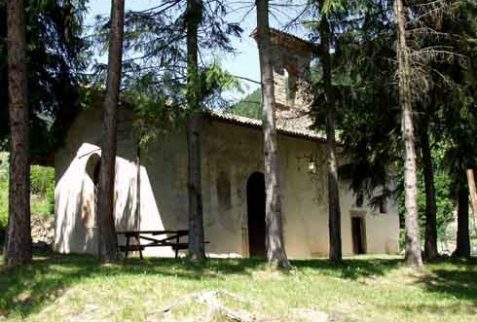Church of San Fiorino
per person
The church of San Fiorino is situated to the north of the village of Borno, in the direction of Lova, to the left of the small valley of the same name.
ORIGINS
There is historical information on its existence as far back as the 1400s: a papal bull issued by Callistus III on 26 October 1456 records a country church as a chapel “Sancti Florinj” in the list of churches of the Valle Camonica that paid contributions to the bishop of Brescia (1410). The small church then appears in the Querinian Catalogue of 1532 and the cult of S. Fiorino in Borno is also mentioned in the deliberations placed as an appendix to the medieval statutes of the Municipality, dated 1446-1447. Restoration work has clarified how the ancient chapel was enlarged on several occasions. The last restoration, carried out around the year 1650, revealed the current structure.
A fairly reliable hypothesis is that the primitive chapel was built on the remains of an ancient pagan temple. This is based on archaeological discoveries dating back to the middle of the last century, when a fragment of a Roman altar bearing a Latin inscription was found, probably in the subsoil of the parish church. The epigraph, which was first placed in one of the side altars and later transferred to the house of the Counts Turrina in Casalbuttano, read: ‘Lucio Sassio, L.F. Ruffo and his sons Valeriano and Ruffino, on purpose and with their money dedicated to Mercury’.
POST-RESTORATION FINDINGS
During recent restoration work carried out in the summer of 1980, three more important finds came to light inside the church:
1) a 15th century fresco, located at the top of the entrance arch to the presbytery, depicting St. Fiorino dressed as a Roman legionnaire, surrounded by a host of angels;
2) an ancient inhumation burial ground, estimated to date back to Roman times, bearing the mutilated inscription ‘LLAESEC’ (probable trade mark);
3) a fragment of white stone, squared and with a groove, which can be traced back to its function as a threshold, similar to another marble block (also with a groove) inserted in the left parapet of the entrance portal.
These latest findings thus reinforce the idea that a small temple dedicated to the Roman god Mercury was built on this site. The present building, as it stands, shows architectural lines of clear 18th-century inspiration. Inside, one can see, especially on the southern wall of the nave and in the oldest part of the church, numerous 16th-century frescoes, almost all mutilated and in a poor state of preservation.




